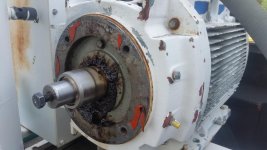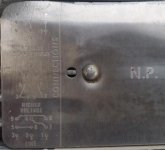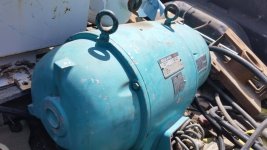Deerehauler
Aluminum
- Joined
- Jan 8, 2017
I am planning to build a rotary phase converter for a 20 HP 3 phase motor that drives a hydraulic pump powering a C-frame press/ironworker.
I hope to use the motor pictured on this Ingersoll Rand rotary screw compressor. It was made in 1986 and has been sitting for at least 22 years. It turns over (which surprised me) and I have removed compressor from the motor since this picture was taken. Since this unit was not shedded, any labels have been faded beyond recognition. I included a picture of the nameplate on the motor, which doesn't help me. I am really hoping someone can tell me more about this motor.
The unit was fed with #2 copper and the starter contacts are rated for 150 amps. The wires going into the motor are #10. The schematic for the panel says that is is for motors ranging from 15 to 40hp. The heaters on the starter are labeled FS-87. I hope this motor is 40hp.
I would appreciate anyone's insight regarding the HP and RPM of this motor. Thank you in advance.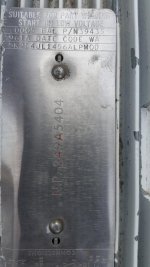
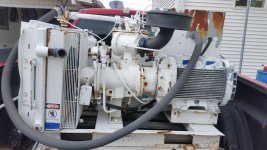
I hope to use the motor pictured on this Ingersoll Rand rotary screw compressor. It was made in 1986 and has been sitting for at least 22 years. It turns over (which surprised me) and I have removed compressor from the motor since this picture was taken. Since this unit was not shedded, any labels have been faded beyond recognition. I included a picture of the nameplate on the motor, which doesn't help me. I am really hoping someone can tell me more about this motor.
The unit was fed with #2 copper and the starter contacts are rated for 150 amps. The wires going into the motor are #10. The schematic for the panel says that is is for motors ranging from 15 to 40hp. The heaters on the starter are labeled FS-87. I hope this motor is 40hp.
I would appreciate anyone's insight regarding the HP and RPM of this motor. Thank you in advance.







